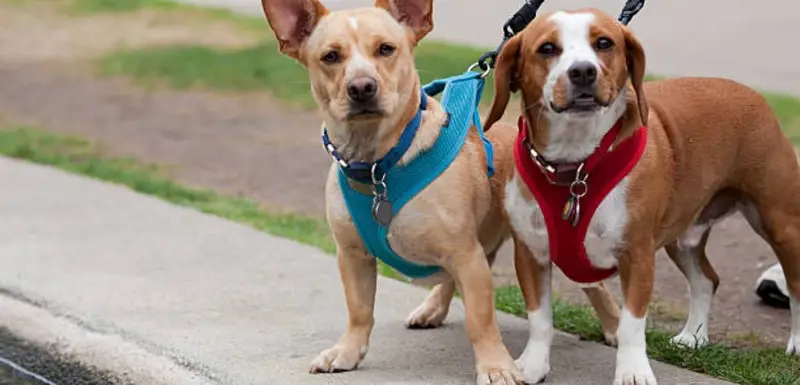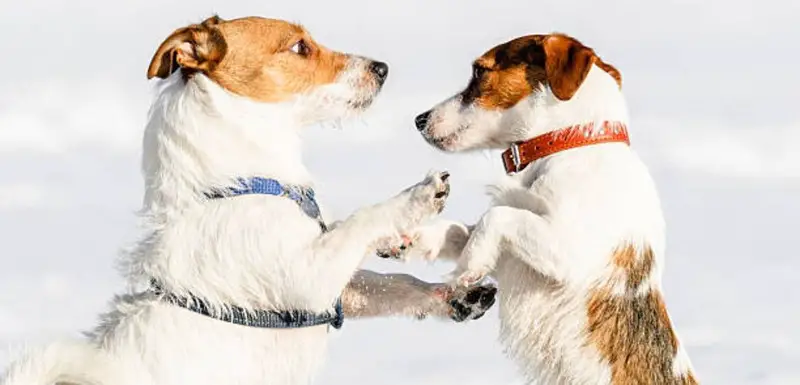
Beginners often get stuck with several questions in mind after getting a harness for their dog. If you already have one, or if you’re thinking about getting a dog harness? Then you have to understand certain things.
Here are 13 facts about dog harnesses that every dog owner should know.
Can Dog Sleep With Harness On
NO, not recommended, and almost all the veterinarians will tell you the same. Because a harness causes a lot of skin problems, including hot spots, irritation, and chafe if a dog wears it during sleep, particularly a wet harness.
Most dangerously, a harness and a collar can unintentionally choke your dog during sleep without even realizing it.
Although, there are many proofs where dogs who sleep with a harness on are often found with rough fur that eventually break and turn into a bald spot.
As well as there are some other risks of leaving a harness on dogs during sleep; it is pretty easy for dogs (especially for puppies) to get their jaw caught on a harness if they ever decide to chew on it.
On the other hand, a dog’s skin needs to breathe; otherwise, his skin can develop sores under the harness which irritates a lot.
And if you aren’t able to discover your dog’s sore, flies might take advantage of that by laying their eggs in the wounds, which turns into maggots within a day.
So, whether you have a puppy or adult dog, just make sure you let your dog’s skin get some air and only use the harness when required.
Is It Safe To Leave The Harness On The Dog All The Time
Veterinarians said it’s not safe to keep dogs in a harness or collar 24/7 because harnesses can easily be caught on objects, which can be hazardous in your absence. And puppies and toy-sized dogs are at higher risk of getting caught anywhere like under the beds, couch, or even in the backyard bushes.
Puppies are full of energy which is why they could easily be caught in something while running around or jumping at home.
Most things that are made for dogs to wear aren’t meant to stay on all day, whether it’s harnesses, collars, leashes, and even winter jackets.
Pet parents often leave their dog on a harness in the backyard, which isn’t safe because dogs can easily get stuck anywhere by the harness, which can be injurious or even life-threatening conditions for them.
Some harnesses are made of lower quality materials plus poorly designed, which can easily cause sores and chafe in the dog’s armpit & belly when the dog gets stuck somewhere and pulls hard to come out.
Hence it’s always better to use a good quality harness that is soft, padded, and durable.
Dog Harness That Can Be Worn All The Time
Certain brands in the market offer “All-Day Wear Harness,” well, it sounds nice; but not comfortable for your four-legged friend.
These all-day wear harnesses often come with soft and high-quality material and good design, which is comfortable for your dog to wear for an hour or two, no doubt.
But still wearing it all the time means 24/7 can lead to fur loss, sores, and some potential dangers.
Sometimes you might not see any signs of discomfort in your dog even if you keep them in a harness for a day or two.
But within few days, you might see some signs of skin irritation such as red rash, fur loss, and bleeding near the armpit.
Can A Dog Harness Hurt A Dog?
It depends on the harness and how often the dog wears it during the day because some are worse than others, depending on fit.
Firstly, if the dog wears it for too long (means 24/7), Yes it can hurt your dog. Secondly, if the harness is wet and made of poor material, Yes it can hurt too and cause skin problems.
Although if the harness is too tight on your dog, it can also hurt and cause serious choking as well. Plus, if the harness is too loose, it could increase the chances for your dog to get hurt in sudden pulls.
So either one way or another, if it’s not used correctly, YES, it can hurt your furry friend.
Dog Harness Injury
According to the vets, animal behaviorists, and dog trainers, several potential harness injuries can happen to your dog and are hazardous as well, such as:
- Chest Injury
- Shoulder Injury
- Skin Irritation
- Choking
Wrongly fitted harnesses are the foremost cause of these injuries in dogs, Which typically means that too tight or loose harnesses are the suspect for those injuries.
Dog Harness Chest Injury
Chest injury can be caused because of two reasons which include a loose harness and sudden pull.
If your dog is a heavy puller, there are great chances for him to get a chest injury because a harness can put an extensive amount of pressure on a dog’s chest if the dog pulls hard on its leash, which can cause chest injuries.
However, if the harness is loose, and the dog suddenly pulls on the leash, it can also cause chest injuries because it also puts high pressure on the dog’s throat region.
So in case you have a leash puller, you can easily protect your dog from chest injuries by using a high-quality soft padded harness.
Dog Harness Shoulder Injury
Using the H-front harness is the most common reason for a dog to get shoulder injuries because the H-front harness puts so much pressure on the dog’s shoulder. That can easily cause damage to their shoulder.
This means that if the H front harness front part is directly located at the point of the shoulder (the joint between the scapula and humerus), it can interfere with his gait and cause problems.
And growing puppies are at higher risk of shoulder injuries with H front harness.
So, to prevent this problem, simply adjust the harness; so it hits above the joint, which keeps your dog safer.
Best Dog Harness For A Shoulder Injury
If a dog suffers from a shoulder injury, it’s always better to use a Y-front harness because these harnesses can’t put pressure on the dog’s shoulder nor their chest.
Here are some great options of Y-front harness for this year for a dog with shoulder injuries.
- PoyPet no pull dog harness
- BARKBAY no pull dog harness
- WINSEE dog harness
- RUFFWEAR front range dog harness
- Auroth tactical dog training harness
Can A Dog Wear A Collar And A Harness At The Same Time

Yes, it’s Ok to keep a dog in a collar and harness at the same time. Although, it’s necessary to keep a collar on (except at night for comfortable sleep) because it helps to attach the ID tags.
While the harness is good for attaching with a leash as it reduces the pressure from the dog’s trachea, the spinal cord, etc.
New dog owners often make the mistake of keeping their puppies early in the collar or harness, which is not good for pups. Only use a harness when the puppy is at least 3 to 4 months old.
Of course, when necessary, you can use a harness for outdoor walks as it is the safest choice for pups.
Do Harnesses Calm Dogs Down?
Yes, some dogs feel calmer with a harness on, particularly puppies, because harnesses work like Anxiety Vests or Body Wraps for them, which makes enough wraparound to calm them up.
A dog who feels calmer with the harness on often falls asleep.
Some dogs are not calmer with harnesses ON because wearing a harness either means a ride or a walk for them, Which makes them super excited that they jump around in the house.
However, if your dog hasn’t worn a harness before, it will make the dog stressed rather than calming or excited.
If the dog gets stressed, he might act very lethargic, and will not show any interest in treats either in outdoor walks.
So, make sure that the dog feels comfortable with the harness before you put it on to him.
Can A Dog Harness Help With Anxiety?
Harnesses are unpredictable, sometimes it does help to overcome an anxiety level of a dog, but sometimes it doesn’t. However, there is an Anxiety Vest available in the market, which helps a lot to calm anxious dogs, whether you have a puppy, adult dog, or shelter dog.
That vest is designed to apply gentle pressure on the dog’s torso to calm over-excitement, anxiety, and fear during the thunder, vet visits, firework, separation, etc.
The anxiety vest almost looks like a fully covered harness, without a handle, buckles, leash attachment point, and other unnecessary things.
What Should I Look For In A Puppy Harness?
There’s a huge difference between a puppy and an adult dog. That’s why you have to be more accurate when purchasing a harness for puppies.
There are several things that you should look into before purchasing a harness for your pup, such as:
- Right Size: Use a harness that correctly fits well to your puppy, meaning not too tight or loose, because if the harness is too loose or tight, it can easily hurt your dog.
- Material: Choose breathable and soft padded material. If the material isn’t breathable and soft, it can irritate your dog badly.
- Durability: Puppies are heavy chewers, so make sure you pick the best option that lasts long. “Here is the best pick.”
- Adjustability: If you don’t want to spend another $ on the harness, consider the adjustable strap harness. So you can adjust the harness according to the puppy’s growth.
- No Decorative Piece: Avoid picking a harness that has decorative pieces like flowers, buttons, Bowtie, etc. These decorative pieces can easily choke your pup if he swallows one.
How To Put The Harness On Puppy Without Biting
Pup’s favorite treats are the easiest way to put the harness on a puppy without biting, but it takes time, at least a day or two.
Just start giving their favorite treats to him when he touches and smells the harness and repeat the process 4 to 5 times.
Then put the harness on but don’t tie it, if he doesn’t resist or bite, reward him with treats and repeat the process 10 times.
Once he seems comfortable with the harness, try to tie it, and if there is no nipping or biting, just reward him again.
Things take time, so don’t get stressed. And don’t scold and punish your pup.
